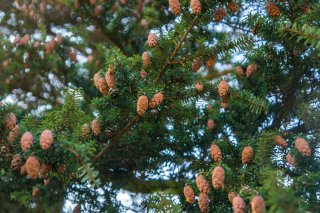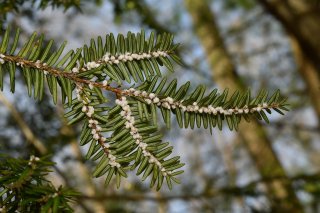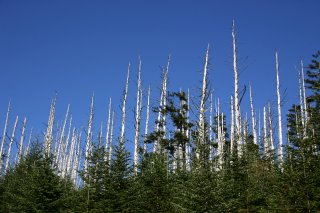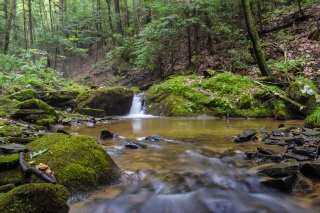Climate Change Connections: Pennsylvania (Eastern Hemlock)
Climate change is impacting all regions and sectors of the United States. The State and Regional Climate Change Connections resource highlights climate change connections to culturally, ecologically, or economically important features of each state and territory. The content on this page provides an illustrative example. As climate change will affect each state and territory in diverse ways, this resource only describes a small portion of these risks. For more comprehensive information about regional climate impacts, please visit the Fifth National Climate Assessment and Climate Change Impacts by Sector.
On this page:
Introduction: Eastern Hemlock’s Historical, Cultural, and Economic Value

Eastern hemlock (Tsuga canadensis) is a member of the pine family and is found in cool, moist areas across Pennsylvania.1 Eastern hemlock forests support and provide habitat for a variety of species.1 As a keystone species, these trees play an important role in regulating stream quality and forest and water temperatures, and cycling nutrients within the environment.1 As Pennsylvania’s state tree, the eastern hemlock has a major presence in Pennsylvania forests and has been the subject of many conservation efforts.
The eastern hemlock has played an important role in Pennsylvania’s cultural and ecological history. These trees were abundant in pre-colonial Pennsylvania forests and provided a valuable resource for Indigenous Peoples of the region. Indigenous Peoples used the tree’s vitamin- and mineral-rich bark, roots, and leaves for medicinal purposes.1 Early European settlers in the region also used the tree’s needles to make tea and the bark to create dye.1
The soft, lightweight wood of eastern hemlock trunks was commercially valuable and harvested in large volumes in Pennsylvania through the 18th and 19th centuries.1 Lumber harvesting led to major deforestation of the region by the 1930s; as a result, the state invested in tree restoration efforts.2 The most common uses for the harvested wood included lumber for crates, beams and frames for general construction and paper pulp.3
Climate Impacts: The Hemlock Woolly Adelgid and Warming Temperatures Threaten Eastern Hemlocks

The invasive pest known as the hemlock woolly adelgid has devastated the eastern hemlock that once dominated the Pennsylvania woods. The adelgid latch on to the tree’s branches and suck its nutrients through the needles, which can kill the tree. Native to Japan, the adelgid was first discovered in the United States in Virginia in 1951 and has continued to migrate north to new areas.4 By the end of 2023, adelgids had spread to trees in all 67 counties in Pennsylvania.5 With no natural predators, the adelgid has been able to spread widely, with devastating impacts on the abundance and health of eastern hemlocks.1 Heavy infestation can kill eastern hemlocks in as few as four years.6Climate change and warming temperatures are expected to exacerbate the threat of hemlock wooly adelgids by allowing their populations to survive and spread. This threat has plagued eastern hemlock for decades in Pennsylvania and across the tree’s range.7
Warmer temperatures across Pennsylvania could also reduce the area in which eastern hemlocks can thrive. Pennsylvania has warmed nearly 2°F since the beginning of the 20th century, and temperatures in the 2000s have been the highest on record.8 This warming trend is expected to continue due to climate change and could threaten the suitability of the eastern hemlock habitat. Eastern hemlocks do best in cool and humid environments.9
Much of the observed temperature increase statewide has occurred in the winter and spring.8Warmer winter months encourage the expansion of hemlock woolly adelgids and increase their impacts on eastern hemlocks.10 The pest has now been observed in every county of Pennsylvania and warmer winter temperatures can make it easier for the population to survive and spread.5,7 With warmer winters, trees that have been protected from the adelgid in the past can become increasingly susceptible to infestation.

As average temperatures rise due to climate change, the Earth’s water cycle has sped up through an increase in the rate of evaporation from the Earth’s surface and transpiration from plants. An increase in evapotranspiration makes more water available in the air for precipitation, but contributes to drying over some land areas, leaving less moisture in the soil.11 Drought is considered a major stressor for eastern hemlocks.1 The stress of drought can also make the trees more susceptible to impacts of diseases and pests. Warming temperatures, drought, and the woolly adelgid all threaten the eastern hemlock and the diverse species that depend on these trees for shelter, shade, and water regulation.
Taking Action: Supporting Forest Health
Addressing climate change requires reducing greenhouse gas emissions while preparing for and protecting against current and future climate impacts. Communities, public officials, and individuals in every part of the United States can continue to explore and implement climate adaptation and mitigation measures. Eastern hemlock forests and other trees also help with carbon sequestration, so protecting and maintaining healthy forest systems is a priority for both climate change mitigation and adaptation.13 In Pennsylvania, forest managers, researchers, and conservation groups are taking steps to promote the resilience of eastern hemlock stands and the surrounding forest ecosystem, including:

- Collaborative research and conservation efforts. Collaborative, multi-landowner efforts have already been implemented to address both eastern hemlock mortality and the spread of the hemlock woolly adelgid. Private and public landowners have collaborated on spatial analysis of eastern hemlock, locating active adelgid infestations, testing pest control treatment options, and generally working to protect hemlock forests.4The Pennsylvania Department of Conservation and Natural Resources developed a comprehensive Hemlock Conservation Plan in 2019 that offers management techniques.1
- Integrating and scaling pest management strategies. Successful pest controls to date include chemical treatments (i.e., insecticides) and biological predators (e.g., the introduction of beetle species that eat hemlock woolly adelgid). However, both chemical and biological controls have risks and limitations in terms of effectiveness, side effects, and economic feasibility that can be weighed as part of well-informed management plans.4, 13
- Forest management. Another strategy already used by some forest managers in Pennsylvania is thinning dead and infested eastern hemlock trees. Removing diseased trees can protect other unaffected trees.14 Thinning can also proactively mitigate hemlock woolly adelgid infestation. For example, one study that thinned and monitored four dense forests of eastern hemlock in northern Pennsylvania over a 10-year period found no adelgid infestations in those forests to date.13 The study also found that less crowded trees with more exposure to sunlight remained healthier and grew bigger. In addition, tree canopies with more direct sunlight were less favorable hosts for the adelgid.13 In areas where hemlocks are no longer thriving, replanting a similar tree species (certain types of conifers) that provide thick cover and similar ecosystem services has been explored as an option to protect habitats.1
To learn more about climate change impacts in Pennsylvania and the Northeast region, see Chapter 21 of the Fifth National Climate Assessment.
Related Resources
- Fifth National Climate Assessment, Chapter 7: Forests
- Fifth National Climate Assessment, Chapter 8: Ecosystems, Ecosystem Services, and Biodiversity
- Pennsylvania State Climate Summary 2022 (NOAA)
- Eastern Hemlock Conservation Plan (Pennsylvania Department of Conservation and Natural Resources Bureau) (pdf) (13.9 MB)
References
1 Faulkenberry, M., Eggen, D. A., & Shultzabarger, E. (2019). Eastern hemlock conservation plan. Pennsylvania Department of Conservation and Natural Resources Bureau of Forestry. https://elibrary.dcnr.pa.gov/PDFProvider.ashx?action=PDFStream&docID=1753173&chksum=&revision=0&docName=dcnr_20030071&nativeExt=pdf
2 Pennsylvania Lumber Museum. (n.d.). Lumber heritage. Retrieved December 6, 2023, from http://lumbermuseum.org/the-pennsylvania-lumber-museum-is-open-to-the-public-year-round-wednesday-through-sunday-from-900-am-to-500-pm/pennsylvania-lumber-history/
3 Nesom, G. (2001). Plant guide: Eastern hemlock. United States Department of Agriculture Natural Resources Conservation Service. https://plants.usda.gov/DocumentLibrary/plantguide/pdf/pg_tsca.pdf
4 Johnson, S., Bearer, S., Hille, A., Stout, S., & Turcotte, R. (2016). Eastern Hemlock Conservation: A Collaborative Approach to Prioritization through a Diverse Partnership. Environmental Practice, 1, 1–12. https://doi.org/10.1017/S1466046616000107
5Pennsylvania Department of Conservation and Natural Resources. (n.d.). Adelges tsugae (hemlock woolly adelgid). Retrieved July 29, 2024, from https://www.dcnr.pa.gov/Conservation/ForestsAndTrees/InsectsAndDiseases/HemlockWoollyAdelgid/Pages/default.aspx
6New York State Department of Environmental Conservation. (n.d.). Hemlock woolly adelgid. Insects & Other Species. https://dec.ny.gov/nature/animals-fish-plants/insects-and-other-species/hemlock-woolly-adelgid
7Ellison, A., Orwig, D., Fitzpatrick, M., & Preisser, E. (2018). The past, present, and future of the hemlock woolly adelgid (Adelges tsugae) and its ecological interactions with eastern hemlock (Tsuga canadensis) forests. Insects, 9(4), 172. https://doi.org/10.3390/insects9040172
8Frankson, R., Kunkel, K. E., Champion, S. M., Stewart, B. C., DeGaetano, A. T., Sweet, W., & Spaccio, J. (2022). Pennsylvania state climate summary 2022 (NOAA Technical Report NESDIS 150-PA). NOAA National Environmental Satellite, Data, and Information Service. https://statesummaries.ncics.org/chapter/pa/
9Godman, R. M., & Lancaster, K. (n.d.). Tsuga canadensis (L.) Carr. U.S. Forest Service. Retrieved December 4, 2023, from https://www.srs.fs.usda.gov/pubs/misc/ag_654/volume_1/tsuga/canadensis.htm
10Paradis, A., Elkinton, J., Hayhoe, K., & Buonaccorsi, J. (2008). Role of winter temperature and climate change on the survival and future range expansion of the hemlock woolly adelgid (Adelges tsugae) in eastern North America. Mitigation and Adaptation Strategies for Global Change, 13(5–6), 541–554. https://doi.org/10.1007/s11027-007-9127-0
11EPA. (2023). Climate change indicators: Drought. Retrieved February 16, 2024, from https://www.epa.gov/climate-indicators/climate-change-indicators-drought
12Domke, G. M., Fettig, C. J., Marsh, A. S., Baumflek, M., Gould, W. A., Halofsky, J. E., Joyce, L. A., LeDuc, S. D., Levinson, D. H., Littell, J. S., Miniat, C. F., Mockrin, M. H., Peterson, D. L., Prestemon, J., Sleeter, B. M., & Swanston, C. (2023). Ch. 7. Forests. In A. R. Crimmins, C. W. Avery, D. R. Easterling, K. E. Kunkel, B. C. Stewart, & T. K. Maycock (Eds.), Fifth National Climate Assessment. U.S. Global Change Research Program. https://doi.org/10.7930/NCA5.2023.CH7
13Fajvan, M. A., & Hille, A. T. (2023). An assessment of eastern hemlock crown dynamics 10-years after thinning on the Allegheny Plateau, Pennsylvania. In C. Kern & Y. L. Dickinson, Proceedings of the first biennial Northern Hardwood Conference 2021: Bridging science and management for the future (pp. 136–146). U.S. Department of Agriculture, Forest Service, Northern Research Station. https://doi.org/10.2737/NRS-GTR-P-211-paper28
14Pennsylvania Department of Conservation and Natural Resources. (2019, October 16). The fight to preserve hemlocks in Pennsylvania. Good Natured. https://www.dcnr.pa.gov/GoodNatured/pages/Article.aspx?post=101

